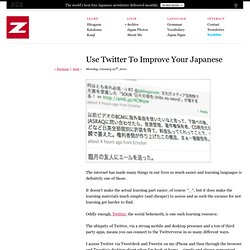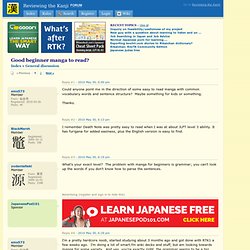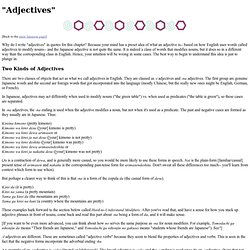

The Japanese Slang Jiko. Use Twitter To Improve Your Japanese. The internet has made many things in our lives so much easier and learning languages is definitely one of those.

It doesn’t make the actual learning part easier, of course ^_^, but it does make the learning materials much simpler (and cheaper) to access and as such the excuses for not learning get harder to find. Oddly enough, Twitter, the social behemoth, is one such learning resource. The ubiquity of Twitter, via a strong mobile and desktop presence and a ton of third party apps, means you can connect to the Twitterverse in so many different ways. I access Twitter via Tweetdeck and Tweetie on my iPhone and then through the browser and Tweetie’s desktop client when I’m back at home – simple and always convenient. Erin's Challenge! I can speak Japanese. Maggie Sensei.
Good beginner manga to read? I'm loving "Yotsuba," and I'm pretty newbish.

In fact, ems573, we may be around the same general level. Light Novels vs Manga reading difficulty? View topic - Japanese Onomatopoeia Guide (Audio Description) Macko Darlack wrote:and if it were to be in kanas... how would it be organized??

Yet, i cannot imagine how to look up a word there!! We'll need help with that, [how do japanese look up a word in the dictionary, i wonder ][/color] They have their own 'arrangements of ABC' in their own language. It is always this sequence - A I U E O KA (GA) KI (GI) KU (GU) KE (GE) KO (GO) SA (ZA) SHI (JI)..... All the way from Ka, Sa, Ta, Na, Ha, Ma, YA YO YU, Ra, and lastly N. Those voiced sounds (with dakuten/handakuten eg: ga, ji, po...) are after the unvoiced ('original') sounds. And when it comes to youon (rya, kyo, pyu...... combinations with small ya/yo/yu), they come after the ones with the big characters. MangaTribe Japanese Onomatopoeia.
Extensive Reading Material Online. Free Japanese Children’s Stories and Fairytales With over 1,000 free Japanese picture books, EhonNavi is like living next to a library!

Sign up here, it’s quick and free. (I wrote a walkthrough to help with this part.) Once you’re logged in, click the link on the right that says 全ページ試し読み to see the available books; click a book and find the yellow icon that says the same thing to read it. There are books for everyone here! You can only read a book once, and if there’s an error of some sort you should be able to re-access the book, as long as it’s within 15 minutes. Reviewing the Kanji. Tofugu. You don't know a language, you live it. You don't learn a language, you get used to it.
Japanese Grammar Guide. This guide was created as a resource for those who want to learn Japanese grammar in a rational, intuitive way that makes sense in Japanese.

The explanations are focused on how to make sense of the grammar not from English but from a Japanese point of view. Before you begin If your computer is not setup to display Japanese, you’ll want to enable Japanese support to read the Japanese text. Other formats Paperback – Available on Amazon.PDF Version – Philipp Kerling wrote an awesome script to convert the site to PDF.iOS app – The guide is now available for iOS devices created by Adam Critchley.Android app – The guide is now available on Google Play created by Ignatius Reza Lesmana. This work is released under a Creative Commons Attribution-Noncommercial-Share Alike License. The problem with conventional textbooks The problem with conventional textbooks is that they often have the following goals. Japanese grammar. Some distinctive aspects of modern Japanese sentence structure[edit] Word order: head final and left branching[edit] The modern theory of constituent order ("word order"), usually attributed to Joseph Greenberg, identifies several kinds of phrase.
Each one has a head and possibly a modifier. The head of a phrase either precedes its modifier (head initial) or follows it (head final). Some of these phrase types, with the head marked in boldface, are: genitive phrase, i.e., noun modified by another noun ("the cover of the book", "the book's cover");noun governed by an adposition ("on the table", "underneath the table");comparison ("[X is] bigger than Y", i.e., "compared to Y, X is big").noun modified by an adjective ("black cat"). Some languages are inconsistent in constituent order, having a mixture of head initial phrase types and head final phrase types.
Japanese "adjectives" [Back to the main Japanese page] Why do I write "adjectives" in quotes for this chapter?

Because your mind has a preset idea of what an adjective is-- based on how English uses words called adjectives to modify nouns-- and the Japanese adjective is not quite the same. It is indeed a class of words that modifies nouns, but it does so in a different way than the corresponding class in English. Hence, your intuition will be wrong in some cases. Story Information for 心の絵本.